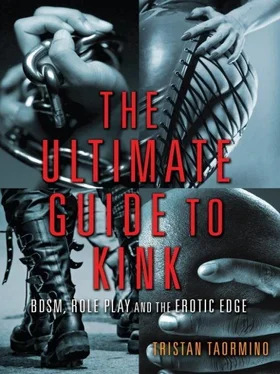—DONNA
Scene or relationship dynamics:master/slave, domestic servitude, sexual service, personal service, 24/7 D/s
A decade after it was so widely embraced, some people began to interpret, critique, and debate the concept of SSC; they questioned whether it sanitized SM and was used to shame people who did more “risky” activities. Sex educators encourage people to practice safer sex, by using barriers, testing regularly, and developing other strategies to reduce the transmission of sexually transmitted infections (STIs). Educators emphasize that it’s safer sex—not safe sex—to make the point that all sex comes with some risks. Likewise, critics of SSC wanted to acknowledge that one can take steps to be safer, but there is some kind of risk in all forms of BDSM.
In 1999, a new phrase was introduced: “risk-aware consensual kink” (RACK). [7] 5 The term RACK is attributed to Gary Switch, who first proposed it on the Eulenspiegel Society’s Listserv “TES-Friends” in 1999. Gary Switch, “Origin of RACK: RACK vs. SSC,” Prometheus 31 (May 1999); online at http://thirst-forbdsmknowledge.blogspot.com/2006/09/origin-of-rack-rack-vs.html .
RACK continues to emphasize the consensual nature of BDSM while acknowledging that some of its practices are inherently risky (and, in fact, exploring the risks and edges are part of what draws people to them). You can make an informed decision to acknowledge the risks, take steps to reduce them, and proceed. Stein himself later clarified the context and intentions behind the creation of SSC and acknowledged some of its limitations:
What we meant by “safe S/M” back in 1983—as the full GMSMA statement of purpose implies—was the opposite of careless, irresponsible, or uninformed S/M. We meant doing your homework and taking reasonable precautions. We never intended to promote only G-rated S/M or to turn the leather scene into a risk-free playpen where pain doesn’t really hurt, bondage isn’t really constraining, and dominance is being ordered to do what you want to do anyway. [8] 6 Stein, 6.
One way to reduce risk is to use a safeword . Although you negotiate and discuss limits, boundaries, and triggers before a scene, you cannot prepare for everything. It’s simply impossible to predict how you’ll feel during a scene, what will push your buttons, or how something will affect you.
A safeword is a word—usually one that you wouldn’t normally utter during a scene—that you and your partner choose. Your safeword is your safety net. If you don’t like something that’s happening and you want the scene to stop right away, simply say your safeword. Words like stop or no or please don’t , which we commonly use to communicate this sentiment, may be part of the dialogue of a scene where the bottom wants to resist or be forced to do something. So they are not ideal safewords. The most common safeword is red . Sometimes people pick two different words; for example, red means “stop right now!” and yellow means “please slow down.” If the bottom can’t speak (he has a gag in his mouth or she is supposed to perform oral sex until you tell her to stop) or the music is really loud in the dungeon, agree on a safe signal instead. For instance, you can have the bottom hold something in her hand during a scene; if she drops it, that means stop.
Another way to reduce risk is to know what you’re doing. Luckily, there is a tremendous emphasis on education in the BDSM community, so take advantage of the resources around you. Learn proper techniques, ask fellow practitioners, attend classes and demonstrations by BDSM educators, and practice skills under the guidance of someone experienced. Learn the risks, the common mistakes that people make, and what is most likely to go wrong. The chance to get some hands-on practice with an experienced person is even better. Don’t get tipsy or do drugs, then decide to try out your new flogger. It’s just like lots of things in life: Cut yourself some slack. Give each other the benefit of the doubt. Use common sense.
Some players believe in what’s called consensual nonconsent , an oxymoron and impossibility by legal definitions, but a concept that makes perfect sense to those who subscribe to it. The idea behind consensual nonconsent is that partners don’t want to go through a list and map out each and every thing that will happen or consent to activities individually. Rather, they want to state their limits, turn their will over to a Dominant, top, or sadist, and trust in where a scene goes. They want to waive their right to revoke their consent or stop in the middle of a scene. In fact, they agree in advance that something might happen that they don’t want or enjoy, or they may be forced to do something that is beyond their comfort zone, and they’re okay with that . You can read more about this idea in Chapters 15, 16, 18, and 19.
I have seen people push the limits of themselves and their partners. Like the leatherman who used only rope to suspend his slave from a tree. The mistress who used a razor-sharp scalpel to create a decorative cutting on her boy’s flesh. Or the daddy who put her entire hand inside a girl’s ass. It might sound like scary stuff when you read it on the page, but no one was harmed during those scenes or hundreds of others I’ve watched. Do you know what is the most common injury at a BDSM conference? A sprained ankle. From walking . It’s true!
Communication
I’ll admit my bias right up front: I think a lot of kinky people are better at communicating their erotic wants, needs, and limits than a lot of nonkinky people. Notice I didn’t say all . Communication is a crucial component to an empowered and fulfilling sex life, and it happens to be a big part of kink. People who get lots of play are the ones who are able to say what they want, put it out there, and negotiate scenes and relationships; it helps that within the community there are people around you modeling the behavior and there are workshops on how to do it more effectively. People talk, for minutes, hours, days, or even months, before they play. They negotiate, ask questions, and reveal themselves.
BRAIN SEX
I’m walking out of a store, it’s late at night. I unlock the car and slide in, shut the door, and suddenly there is a knife at my throat. I can see a bit of the rearview mirror and a figure in black. A rough deep voice tells me to shut up and drive. We pull up at a warehouse and a couple other guys all dressed in black, faces covered, come out and drag me from the car. I fight but it does no good. Someone puts a chloroform rag over my nose and mouth to stop me from screaming and fighting. The world goes dark…
I come to, and my wrists and ankles are bound and something is in my mouth. I can’t see anything but I feel cold wires of some kind underneath me. I feel hands all over me, I realize I am in only my bra and panties. So many hands—grabbing, feeling, slapping—and voices insulting me. I feel the sharpness of a knife blade. One of them pulls something off my head, a hood. As I try to focus, still groggy, I see figures. I’m in some kind of dark creepy warehouse. My vision is clearer and I realize I am bound to an old rusty metal bed. The wires I feel are the bare springs of a mattress. I try to scream and can’t. As I tug on the binds, I realize it’s duct tape and I am not getting out of it.
—KYLIE
Role play and psychological play:animal role play, age play, taboo play, mindfuck, interrogation, objectification, humiliation, kidnapping, orgasm control/denial, forced cross-dressing, medical play
Tools:imagination, costumes, props
Читать дальше












